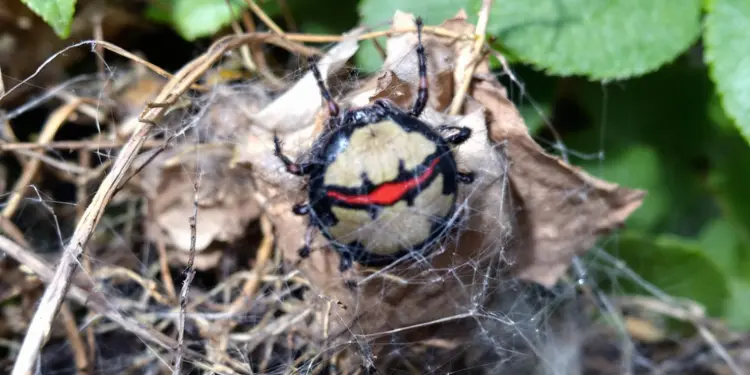Many people are wary of spiders and seek information about them. The redback spider scientific name, Latrodectus hasselti, holds intriguing significance. This post will explain the meaning and importance of this name.
Let’s explore one of Australia’s most well-known spiders.
Key Takeaways
- The redback spider’s scientific name is Latrodectus hasselti, first described in 1870 by Tamerlan Thorell.
- Female redbacks are about 1 cm long, while males are only 3-4 mm. Females can live for 2-3 years and produce 4-10 egg sacs in their lifetime.
- Redback venom is highly toxic, with a median lethal dose of 0.27-0.91 mg per kg in mice. Between 2,000-10,000 Aussies are bitten yearly, with 250 needing antivenom.
- These spiders are native to Australia but have spread to parts of Asia, New Zealand, and the USA through trade.
- No deaths from redback bites have occurred since 1956, when an antivenom was created. However, recent studies question if it works better than a placebo.

Taxonomy and Naming

The Redback spider’s scientific name is Latrodectus hasselti. Tamerlan Thorell first described this spider in 1870. It belongs to the Latrodectus genus, which includes other widow spiders.
The Redback is part of the Theridiidae family, known as comb-footed spiders. These arachnids sit in the Araneae order and Arachnida class.
The Redback has several alternative names. Some refer to it as the red-back spider or red-striped spider. Others use red-spot spider or jockey spider. In Aboriginal languages, it’s known as Murra-ngura, Kapara, or Kanna-jeri spider.
These names often relate to the spider’s appearance or habitat. The Redback is a significant species in Australia’s spider fauna, recognised for its venomous bite and distinctive red stripe.
Description and Physical Characteristics
Redback spiders exhibit significant size differences between males and females. Female redbacks are considerably larger, measuring about 1 cm in length. Males are comparatively small, only 3 to 4 mm long.
This size disparity makes it easy to distinguish between them.
Female redbacks possess potent venom. Each bite can deliver 0.08 to 0.10 mg of venom. This amount is highly toxic – the median lethal dose for mice is just 0.27 to 0.91 mg per kg of body weight.
Young female redbacks have an unusual characteristic: they lack external openings for mating. This fact is unexpected for many arachnologists. We will now examine the habitats where these spiders reside and flourish.
Distribution and Habitat
Moving from the redback spider’s appearance, we’ll explore its habitat. These spiders are native to Australia. They flourish in urban and rural areas across the country. They can be found in Brisbane, Perth, and Alice Springs.
Redbacks prefer dry, dark locations. They seek shelter in places like sheds and garages. Over time, they’ve expanded beyond Australia. International trade has introduced them to new regions.
Currently, they inhabit parts of Asia, New Zealand, and even the USA. RedbackSpider.com observes that these spiders adapt effectively to urban environments. This facilitates their spread to new locations.
Life Cycle and Reproduction
Redback spiders have a unique life cycle and breeding habits. These are the key stages and facts about their reproduction:
- Females can store sperm for up to two years after mating
- A female redback spider produces 4 to 10 egg sacs in her lifetime
- Each egg sac contains about 250 eggs
- Male redbacks mature in 90 days and live for 6 to 7 months
- Female redbacks take 4 months to mature and live for 2 to 3 years
- The egg sacs are round and measure about 1 cm across
- Males often perish after mating due to the female’s cannibalistic behaviour
- Spiderlings emerge from the eggs after about 3 weeks
- Young spiders may consume each other if food is scarce
- Females can create new egg sacs without mating again thanks to stored sperm
- The breeding season for redbacks occurs mainly in the warmer months
- Redback spiders can reproduce all year in suitable conditions
- Female redbacks can produce hundreds of eggs in their lifetime
- Male redbacks are much smaller than females and have shorter lives
- The survival rate of baby redbacks is low due to predators and lack of food
Comparison of Redback Spider with Similar Species
Redback spiders have similar-looking relatives. We can compare them to the Grey House Spider and Cupboard Spider to identify the differences.
Table comparing Redback Spider with Grey House Spider and Cupboard Spider
Comparing the Redback Spider with its close relatives provides information about their unique traits. Here’s a comparison of how the Redback compares to the Grey House Spider and Cupboard Spider:
| Feature | Redback Spider | Grey House Spider | Cupboard Spider |
|---|---|---|---|
| Female Size | 1 cm (10 mm) | 7-12 mm | 8-10 mm |
| Male Size | 3-4 mm | 5-7 mm | 4-5 mm |
| Colour | Black with red stripe | Grey or brown | Dark brown or black |
| Venom Toxicity | High (LD50: 0.27–0.91 mg/kg) | Low | Moderate |
| Habitat | Urban areas, gardens | Houses, gardens | Dark corners, cupboards |
This table displays key differences between these spiders. The Redback is notable for its smaller male size and more toxic venom. Its distinctive red stripe also differentiates it from the Grey House and Cupboard spiders.
Venom and Its Effects
Redback spider venom is highly potent. Its primary component is alpha-latrotoxin, a toxin that affects the nervous system. This results in intense pain, perspiration, and nausea in humans.
Annually, between 2,000 and 10,000 Australians experience redback spider bites. Approximately 250 of these cases require antivenom treatment.
Fortunately, no fatalities have occurred from a redback bite since 1956. This coincides with the development of an antivenom derived from horse blood. A single vial can counteract 5 mg of venom.
Yet, some researchers now question the efficacy of the antivenom. Recent studies indicate it may be no more effective than a placebo. Despite this, medical professionals often administer it in severe cases.
Exploring the Web of Latrodectus Hasselti Thorell
The latrodectus hasselti thorell is a captivating spider built in dry areas, drawing interest from enthusiasts at RedBackSpider.com. This post is worth reading because it delves into this venomous spider’s unique traits, its invasion history, and how it survives in proximity to human dwellings.
What Is Latrodectus?
Latrodectus is a family theridiidae genus that includes the australian redback spider and several batches of eggs. Each spider latrodectus can have a stripe on the upper abdomen, with a prominent red stripe or absence of a red dorsal patch.
Why Focus on Latrodectus Hasselti?
Latrodectus hasselti is a species of latrodectus with a light brown or brownish abdomen, sometimes showing white markings on the upper side. Its male spider is smaller, while the female spider often sports a stripe on the upper side of the abdomen.
How Do They Build a Web?
The spider’s web features sticky catching threads and long silk threads that run to ground attachments. Spiders also steal prey from others. A wasp parasitizing latrodectus hasselti thorell was once documented, showing a record of a spider wasp in western australian museum supplement archives.
Do They Lay Batches of Eggs?
Yes. When a female has mated, it may produce a period of up to two or more egg sacs. Several batches of eggs each contains approximately 250 eggs. Once spiderlings hatch, they can become spiderlings are cannibalistic if food is scarce, as shown in food deprivation on latrodectus hasselti notes.
Are Male Redback Spiders Different?
Male redback spiders have a smaller abdomen, slender legs, and a stripe on the upper abdomen. They’re part of latrodectus hasseltii thorell but whereas males only live a shorter span.
Comparison Table: Key Features
| Feature | Details |
|---|---|
| Marking on the underside | Sometimes a red dorsal stripe |
| White markings on the upper | Present in juveniles have additional white markings |
| Number of species in genus | Many, per world spider catalog and australian geographic |
| Spider is usually | A venomous spider in australian spiders lists |
- Back of the abdomen often shows red markings
- Trapdoor spiders differ from this spider latrodectus hasseltii
- Male redback can appear with a brownish body colour
- If this spider is disturbed, it may defend itself vigorously
Conclusion
The Latrodectus hasselti, or Redback Spider, is a unique Australian creature. Its red stripe and potent venom make it distinct. We’ve gained knowledge about its life, habits, and effects on humans.
Understanding more about this spider helps us maintain safety and respect for nature. The next time you observe a Redback, you’ll recognise exactly what you’re seeing!
FAQs
1. What’s the Redback Spider Scientific Name, and why’s it called that?
The redback spider’s scientific name is Latrodectus hasselti. It’s named after… well, its red back! The ‘Latrodectus’ bit refers to the genus of widow spiders, while ‘hasselti’ honours the Aussie naturalist A.H. Hasselt.
2. Are redbacks found only in Australia, or do they live elsewhere too?
Redbacks are true-blue Aussies, but… they’re not shy about travel. While they’re mainly found in Australia, these eight-legged tourists have popped up in New Zealand, Japan, and even Belgium! Talk about getting around.
3. How dangerous is a redback bite to humans?
A redback bite can pack a punch, but it’s rarely fatal. Symptoms might include pain, sweating, nausea, and vomiting. It’s more serious for kids and older folks, though. If bitten, it’s best to see a doc quick smart.
4. What’s the difference between a redback and a black widow spider?
Redbacks and black widows are cousins, both part of the Latrodectus family. The main difference? Redbacks sport a red stripe on their back, while black widows have a red hourglass on their belly. Both are venomous, but redbacks are more common in Oz.





